A Low-Cost System for Measuring Wind Speed and Direction Using Thermopile Array and Artificial Neural Network
Abstract
:Featured Application
Abstract
1. Introduction
- Rotating parts in cup anemometers and wind vanes are prone to degradation and faults over time and result in inaccurate readings.
- Many applications are constrained by size, and a wind flow trajectory may not be suitable for rotating anemometers.
- In order to encourage the use of such sensors in residential setups, the cost of a system should be affordable.
- Costs of wind speed and direction measurement systems are highly influenced by the components used for sensing the wind attributes. Therefore, technology that is more sophisticated may provide a higher accuracy but may lead to significantly higher system costs.
- This study reports on the development of a low-cost wind speed and direction sensing system using easily available and low-cost components, including a thermopile array, a PTC heater, a heat sink, and an ambient temperature sensor.
- The proposed device does not have any rotating or moving parts, hence, it requires less maintenance and can transfer measurement data wirelessly without a need for wires.
- The use of an artificial neural network (ANN) to estimate the wind speed and direction from the thermal distribution using data collected from the thermopile array and ambient temperature sensor with a high coefficient of determination (R2 score) at different sampling intervals.
- An artificial neural network (ANN) is trained on the thermopile array, and ambient temperature sensor data can provide a significantly higher R2 score for wind speed and direction estimation than the SVM and LR methods.
- For the evaluation of system, 96 h of data are used for training the ANN model and 72 h of data are used for the testing the model performance.
2. Related Works
3. Methodology
3.1. Design of Device
3.2. System Architecture
4. Results
4.1. Experimental Setup and Dataset
4.2. Estimation Results
5. Conclusions
- Our proposed system could achieve an R2 score of up to 0.99 and 0.941 for wind speed and direction estimation using the ANN regression model, respectively, at a 10-min sampling interval with MAE being 0.07 m/s and 13.657°, respectively.
- The R2 score, RMSE and MAE of the proposed system at sampling intervals of 5 min, 2 min, 1 min and 20 s were well under acceptable limits.
- The ANN method outperformed SVM regression by 2.2% in terms of R2 score, 44.7% in RMSE, and 44.5% in MAE for wind speed estimation at a 10-min interval.
- The ANN method outperformed LR by 9% in terms of R2 score, 28.7% in RMSE and 24% in MAE for wind direction estimation at a 10-min interval.
- The relatively lower accuracy for wind direction estimation at smaller sampling intervals, which is suspected to be due to the lower spatial resolution of the thermopile array and the design of the heat sink that restricts the airflow from some directions.
- The wind speed and direction accuracy decrease with a shorter sampling rate because the changes in thermal distribution are not recorded as quickly as the changes in wind attributes.
Author Contributions
Funding
Data Availability Statement
Acknowledgments
Conflicts of Interest
Appendix A










References
- Knorr, K. Modellierung von raum-zeitlichen Eigenschaften der Windenergieeinspeisung für wetterdatenbasierte Windleistungssimulationen; Dissertation zur Erlangung des akademischen Grades Vorgelegt im Fachbereich Elektrotechnik/Informatik; Universität Kassel: Kassel, Germany, 2018. [Google Scholar]
- Staffell, I.; Pfenninger, S. Using bias-corrected reanalysis to simulate current and future wind power output. Energy 2016, 114, 1224–1239. [Google Scholar] [CrossRef] [Green Version]
- Gökmen, N.; Hu, W.; Hou, P.; Chen, Z.; Sera, D.; Spataru, S. Investigation of wind speed cooling effect on PV panels in windy locations. Renew. Energy 2016, 90, 283–290. [Google Scholar] [CrossRef]
- Bhattacharya, T.; Chakraborty, A.K.; Pal, K. Effects of Ambient Temperature and Wind Speed on Performance of Monocrystalline Solar Photovoltaic Module in Tripura, India. J. Sol. Energy 2014, 2014, 1–5. [Google Scholar] [CrossRef] [Green Version]
- Camargo, L.R.; Nitsch, F.; Gruber, K.; Valdes, J.; Wuth, J.; Dorner, W. Potential analysis of hybrid renewable energy systems for self-sufficient residential use in Germany and the Czech Republic. Energies 2019, 12, 4185. [Google Scholar] [CrossRef] [Green Version]
- Chen, F.; Lu, S.M.; Tseng, K.T.; Lee, S.C.; Wang, E. Assessment of renewable energy reserves in Taiwan. Renew. Sustain. Energy Rev. 2010, 14, 2511–2528. [Google Scholar] [CrossRef]
- Vladislavleva, E.; Friedrich, T.; Neumann, F.; Wagner, M. Predicting the energy output of wind farms based on weather data: Important variables and their correlation. Renew. Energy 2013, 50, 236–243. [Google Scholar] [CrossRef] [Green Version]
- Yimen, N.; Tchotang, T.; Kanmogne, A.; Idriss, I.A.; Musa, B.; Aliyu, A.; Okonkwo, E.C.; Abba, S.I.; Tata, D.; Meva’a, L.; et al. Optimal sizing and techno-economic analysis of hybrid renewable energy systems—A case study of a photovoltaic/wind/battery/diesel system in Fanisau, Northern Nigeria. Processes 2020, 8, 1381. [Google Scholar] [CrossRef]
- Ghofrani, M.; Hosseini, N.N. Optimizing Hybrid Renewable Energy Systems: A Review. In Sustainable Energy—Technological Issues, Applications and Case Studies; IntechOpen: London, UK, 2016. [Google Scholar]
- Alaaeddin, M.H.; Zakaria, A.; Jani, J.M.; Seyajah, N. Optimization Techniques and Multi-Objective Analysis in Hybrid Solar-Wind Power Systems for Grid-Connected Supply. Proc. IOP Conf. Ser. Mater. Sci. Eng. 2019, 538, 6–12. [Google Scholar] [CrossRef]
- Shivam, K.; Tzou, J.-C.; Wu, S.-C. Multi-Objective Sizing Optimization of a Grid-Connected Solar–Wind Hybrid System using Climate Classification: A Case Study of Four Locations in Southern Taiwan. Energies 2020, 13, 2505. [Google Scholar] [CrossRef]
- Zupančič, J.; Filipič, B.; Gams, M. Genetic-programming-based multi-objective optimization of strategies for home energy-management systems. Energy 2020, 203, 117769. [Google Scholar] [CrossRef]
- Dahmane, M.; Bosche, J.; El-Hajjaji, A. Power management strategy based on weather prediction for hybrid stand-Alone system. Energy Procedia 2015, 83, 330–340. [Google Scholar] [CrossRef] [Green Version]
- Agüera-Pérez, A.; Palomares-Salas, J.C.; González de la Rosa, J.J.; Florencias-Oliveros, O. Weather forecasts for microgrid energy management: Review, discussion and recommendations. Appl. Energy 2018, 228, 265–278. [Google Scholar] [CrossRef]
- Vera, Y.E.G.; Dufo-López, R.; Bernal-Agustín, J.L. Energy management in microgrids with renewable energy sources: A literature review. Appl. Sci. 2019, 9, 3854. [Google Scholar] [CrossRef] [Green Version]
- Atanasijevic, P.; Mihailovic, P. Temperature compensation of NTC thermistors based anemometer. Sens. Actuators A Phys. 2019, 285, 210–215. [Google Scholar] [CrossRef]
- Chen, B.; Zhu, Y.Q.; Yi, Z.; Qin, M.; Huang, Q.A. Temperature effects on the wind direction measurement of 2D solid thermal wind sensors. Sensors 2015, 15, 29871–29881. [Google Scholar] [CrossRef] [Green Version]
- Chang, C.C.; Lin, C.J. LIBSVM: A Library for support vector machines. ACM Trans. Intell. Syst. Technol. 2011, 2, 27. [Google Scholar] [CrossRef]
- Mickey, R.; Rencher, A.C. Methods of Multivariate Analysis; Wiley: Hoboken, NJ, USA, 1998; Volume 93, ISBN 0471418897. [Google Scholar]
- Yakunin, A.G. 3D Ultrasonic Anemometer with tetrahedral arrangement of sensors. J. Phys. Conf. Ser. 2017, 881. [Google Scholar] [CrossRef] [Green Version]
- Ghahramani, A.; Zhu, M.; Przybyla, R.J.; Andersen, M.P.; Galicia, P.J.; Peffer, T.E.; Zhang, H.; Arens, E. Measuring Air Speed with a Low-Power MEMS Ultrasonic Anemometer via Adaptive Phase Tracking. IEEE Sens. J. 2019, 19, 8136–8145. [Google Scholar] [CrossRef] [Green Version]
- Ma, B.; Teng, J.; Zhu, H.; Zhou, R.; Ju, Y.; Liu, S. Three-dimensional wind measurement based on ultrasonic sensor array and multiple signal classification. Sensors 2020, 20, 523. [Google Scholar] [CrossRef] [Green Version]
- Gao, Y.; Ramirez, B.C.; Hoff, S.J. Omnidirectional thermal anemometer for low airspeed and multi-point measurement applications. Comput. Electron. Agric. 2016, 127, 439–450. [Google Scholar] [CrossRef] [Green Version]
- Palma, J.; Labbé, R. Rugged constant-temperature thermal anemometer. Rev. Sci. Instrum. 2016, 87, 125112. [Google Scholar] [CrossRef] [Green Version]
- Perry, A.E.; Morrison, G.L. A study of the constant-temperature hot-wire anemometer. J. Fluid Mech. 1971, 47, 577–599. [Google Scholar] [CrossRef]
- Shen, C.H.; Lin, P.H.; Chen, S.J. Research on an ultra-low power thermoelectric-type anemometer. IOP Conf. Ser. Mater. Sci. Eng. 2018, 383, 012021. [Google Scholar] [CrossRef] [Green Version]
- Piotto, M.; Dei, M.; Pennelli, G.; Bruschi, P. A Miniaturized 2D Solid State Anemometer Based on Thermal Flow Sensors. Procedia Chem. 2009, 1, 1463–1466. [Google Scholar] [CrossRef]
- Zhu, Y.; Chen, B.; Qin, M.; Huang, Q.A. 2-D Micromachined Thermal Wind Sensors—A Review. IEEE Internet Things J. 2014, 1, 216–232. [Google Scholar] [CrossRef]
- Shi, M.; Holmes, A.S.; Yeatman, E.M. Piezoelectric wind velocity sensor based on the variation of galloping frequency with drag force. Appl. Phys. Lett. 2020, 116. [Google Scholar] [CrossRef]
- Leoni, A.; Stornelli, V.; Pantoli, L. A low-cost portable spherical directional anemometer for fixed points measurement. Sens. Actuators A Phys. 2018, 280, 543–551. [Google Scholar] [CrossRef]
- Li, G.Z.; Zhao, S.; Zhu, R. Wearable Anemometer with Multi-Sensing of Wind Absolute Orientation, Wind Speed, Attitude, and Heading. IEEE Sens. J. 2019, 19, 297–303. [Google Scholar] [CrossRef]
- Liu, C.; Shi, Y.; Yu, X.; Wang, T.; King, M.D. Design of thermal wind sensor with constant power control and wind vector measurement method. PLoS ONE 2020, 15, 1–22. [Google Scholar] [CrossRef] [PubMed]
- Nezhad, M.M.; Neshat, M.; Heydari, A.; Razmjoo, A.; Piras, G.; Garcia, D.A. A new methodology for offshore wind speed assessment integrating Sentinel-1, ERA-Interim and in-situ measurement. Renew. Energy 2021, 172, 1301–1313. [Google Scholar] [CrossRef]
- Zhang, Y.; Pan, G.; Chen, B.; Han, J.; Zhao, Y.; Zhang, C. Short-term wind speed prediction model based on GA-ANN improved by VMD. Renew. Energy 2020, 156, 1373–1388. [Google Scholar] [CrossRef]
- Neshat, M.; Nezhad, M.M.; Abbasnejad, E.; Mirjalili, S.; Tjernberg, L.B.; Astiaso Garcia, D.; Alexander, B.; Wagner, M. A deep learning-based evolutionary model for short-term wind speed forecasting: A case study of the Lillgrund offshore wind farm. Energy Convers. Manag. 2021, 236, 114002. [Google Scholar] [CrossRef]
- Filik, Ü.B.; Filik, T. Wind Speed Prediction Using Artificial Neural Networks Based on Multiple Local Measurements in Eskisehir. Energy Procedia 2017, 107, 264–269. [Google Scholar] [CrossRef]
- Huang, C.J.; Kuo, P.H. A short-term wind speed forecasting model by using artificial neural networks with stochastic optimization for renewable energy systems. Energies 2018, 11, 2777. [Google Scholar] [CrossRef] [Green Version]
- Zhang, D.; Peng, X.; Pan, K.; Liu, Y. A novel wind speed forecasting based on hybrid decomposition and online sequential outlier robust extreme learning machine. Energy Convers. Manag. 2019, 180, 338–357. [Google Scholar] [CrossRef]
- Qin, Q.; Lai, X.; Zou, J. Direct multistep wind speed forecasting using LSTM neural network combining EEMD and fuzzy entropy. Appl. Sci. 2019, 9, 126. [Google Scholar] [CrossRef] [Green Version]
- Shivam, K.; Tzou, J.-C.; Wu, S.-C. Multi-Step Short-Term Wind Speed Prediction Using a Residual Dilated Causal Convolutional Network with Nonlinear Attention. Energies 2020, 13, 1772. [Google Scholar] [CrossRef] [Green Version]
- Jiang, P.; Qin, S.; Wu, J.; Sun, B. Time Series Analysis and Forecasting for Wind Speeds Using Support Vector Regression Coupled with Artificial Intelligent Algorithms. Math. Probl. Eng. 2015, 2015, 939305. [Google Scholar] [CrossRef] [Green Version]
- Gangwar, S.; Bali, V.; Kumar, A. Comparative Analysis of Wind Speed Forecasting Using LSTM and SVM. ICST Trans. Scalable Inf. Syst. 2018, 7, 159407. [Google Scholar] [CrossRef]
- Laref, R.; Losson, E.; Sava, A.; Siadat, M. Support vector machine regression for calibration transfer between electronic noses dedicated to air pollution monitoring. Sensors 2018, 18, 3716. [Google Scholar] [CrossRef] [Green Version]
- Ma, Y.; Xie, S.; Zhang, X.; Luo, Y. Hybrid calibration method for six-component force/torque transducers of wind tunnel balance based on support vector machines. Chin. J. Aeronaut. 2013, 26, 554–562. [Google Scholar] [CrossRef] [Green Version]
- Garcia-Ruiz, R.A.; Blanco-Claraco, J.L.; Lopez-Martinez, J.; Callejon-Ferre, A.J. Uncertainty-Aware Calibration of a Hot-Wire Anemometer With Gaussian Process Regression. IEEE Sens. J. 2019, 19, 7515–7524. [Google Scholar] [CrossRef]
- Cho, W.J.; Kim, H.J.; Jung, D.H.; Han, H.J.; Cho, Y.Y. Hybrid signal-processing method based on neural network for prediction of NO3, K, Ca, and Mg ions in hydroponic solutions using an array of ion-selective electrodes. Sensors 2019, 19, 5508. [Google Scholar] [CrossRef] [PubMed] [Green Version]
- Azad, A.K.; Wang, L.; Guo, N.; Tam, H.-Y.; Lu, C. Signal processing using artificial neural network for BOTDA sensor system. Opt. Express 2016, 24, 6769. [Google Scholar] [CrossRef]
- Bisgin, H.; Bera, T.; Ding, H.; Semey, H.G.; Wu, L.; Liu, Z.; Barnes, A.E.; Langley, D.A.; Pava-Ripoll, M.; Vyas, H.J.; et al. Comparing SVM and ANN based Machine Learning Methods for Species Identification of Food Contaminating Beetles. Sci. Rep. 2018, 8, 1–12. [Google Scholar] [CrossRef] [PubMed]
- Patel, J.P.; Upadhyay, S.H. Comparison between Artificial Neural Network and Support Vector Method for a Fault Diagnostics in Rolling Element Bearings. Procedia Eng. 2016, 144, 390–397. [Google Scholar] [CrossRef] [Green Version]
- Shivam, K.; Tzou, J.; Wu, S. A multi-objective predictive energy management strategy for residential grid-connected PV-battery hybrid systems based on machine learning technique. Energy Convers. Manag. 2021, 237, 114103. [Google Scholar] [CrossRef]
- Wang, J.H.; Lin, G.F.; Chang, M.J.; Huang, I.H.; Chen, Y.R. Real-Time Water-Level Forecasting Using Dilated Causal Convolutional Neural Networks. Water Resour. Manag. 2019, 33, 3759–3780. [Google Scholar] [CrossRef]
- Khosravi, A.; Koury, R.N.N.; Machado, L.; Pabon, J.J.G. Prediction of wind speed and wind direction using artificial neural network, support vector regression and adaptive neuro-fuzzy inference system. Sustain. Energy Technol. Assess. 2018, 25, 146–160. [Google Scholar] [CrossRef]
- Chevalier, R.F.; Hoogenboom, G.; McClendon, R.W.; Paz, J.A. Support vector regression with reduced training sets for air temperature prediction: A comparison with artificial neural networks. Neural Comput. Appl. 2011, 20, 151–159. [Google Scholar] [CrossRef]
- Li, X.; Sha, J.; Wang, Z.L. A comparative study of multiple linear regression, artificial neural network and support vector machine for the prediction of dissolved oxygen. Hydrol. Res. 2017, 48, 1214–1225. [Google Scholar] [CrossRef]
- Ouma, Y.O.; Okuku, C.O.; Njau, E.N. Use of Artificial Neural Networks and Multiple Linear Regression Model for the Prediction of Dissolved Oxygen in Rivers: Case Study of Hydrographic Basin of River Nyando, Kenya. Complexity 2020, 2020. [Google Scholar] [CrossRef]
- Tosun, E.; Aydin, K.; Bilgili, M. Comparison of linear regression and artificial neural network model of a diesel engine fueled with biodiesel-alcohol mixtures. Alex. Eng. J. 2016, 55, 3081–3089. [Google Scholar] [CrossRef] [Green Version]
- Tsakiri, K.; Marsellos, A.; Kapetanakis, S. Artificial neural network and multiple linear regression for flood prediction in Mohawk River, New York. Water 2018, 10, 1158. [Google Scholar] [CrossRef] [Green Version]
- Aprillia, H.; Yang, H.T.; Huang, C.M. Optimal decomposition and reconstruction of discrete wavelet transformation for short-term load forecasting. Energies 2019, 12, 4654. [Google Scholar] [CrossRef] [Green Version]
- Ting, Y.H. Self-Regulating PTC Heating Systems: A New Approach for Electric Heating Appliances. IEEE Trans. Ind. Appl. 1972, IA-8, 338–344. [Google Scholar] [CrossRef]
- Li, J.; Chang, C.; Li, X.; Li, Y.; Guan, G. A new thermal controlling material with positive temperature coefficient for body warming: Preparation and characterization. Materials 2019, 12, 1758. [Google Scholar] [CrossRef] [PubMed] [Green Version]
- SparkFun. Grid-EYE Infrared Array Breakout—AMG8833 (Qwiic). Available online: https://www.sparkfun.com/products/14607 (accessed on 15 January 2021).
- LILYGO®. T-Micro32 V2.0 Wifi wireless Bluetooth Module ESP32 PICO-D4 IPEX ESP-32(1). Available online: http://www.lilygo.cn/prod_view.aspx?TypeId=50033&Id=1091&FId=t3:50033:3 (accessed on 15 January 2021).
- Hornik, K.; Stinchcombe, M.; White, H. Multilayer feedforward networks are universal approximators. Neural Netw. 1989, 2, 359–366. [Google Scholar] [CrossRef]
- Liu, D.; Yuan, Y.; Liao, S. Artificial neural network vs. nonlinear regression for gold content estimation in pyrometallurgy. Expert Syst. Appl. 2009, 36, 10397–10400. [Google Scholar] [CrossRef]
- Lecun, Y.; Bengio, Y.; Hinton, G. Deep learning. Nature 2015, 521, 436–444. [Google Scholar] [CrossRef]
- Stangierski, J.; Weiss, D.; Kaczmarek, A. Multiple regression models and Artificial Neural Network (ANN) as prediction tools of changes in overall quality during the storage of spreadable processed Gouda cheese. Eur. Food Res. Technol. 2019, 245, 2539–2547. [Google Scholar] [CrossRef] [Green Version]
- Landi, A.; Piaggi, P.; Laurino, M.; Menicucci, D. Artificial neural networks for nonlinear regression and classification. In Proceedings of the 2010 10th International Conference on Intelligent Systems Design and Applications, Cairo, Egypt, 29 November–1 December 2010; pp. 115–120. [Google Scholar] [CrossRef]
- Jamieson, K.; Talwalkar, A. Non-stochastic best arm identification and hyperparameter optimization. arXiv 2016, arXiv:1502.07943. [Google Scholar]
- Kingma, D.P.; Ba, J.L. Adam: A method for stochastic optimization. arXiv 2014, arXiv:1412.6980. [Google Scholar]
- Pedregosa, F.; Varoquaux, G.; Gramfort, A.; Michel, V.; Thirion, B.; Grisel, O.; Blondel, M.; Prettenhofer, P.; Weiss, R.; Dubourg, V.; et al. Scikit-learn: Machine Learning in Python. J. Mach. Learn. Res. 2011, 12, 2825–2830. [Google Scholar]
- Bucchianico, A. DiCoefficient of Determination (R2). In Wiley StatsRef: Statistics Reference Online; John Wiley & Sons Ltd.: Chichester, UK, 2014; pp. 1–2. [Google Scholar]
- Colin Cameron, A.; Windmeijer, F.A.G. An R-squared measure of goodness of fit for some common nonlinear regression models. J. Econom. 1997, 77, 329–342. [Google Scholar] [CrossRef]



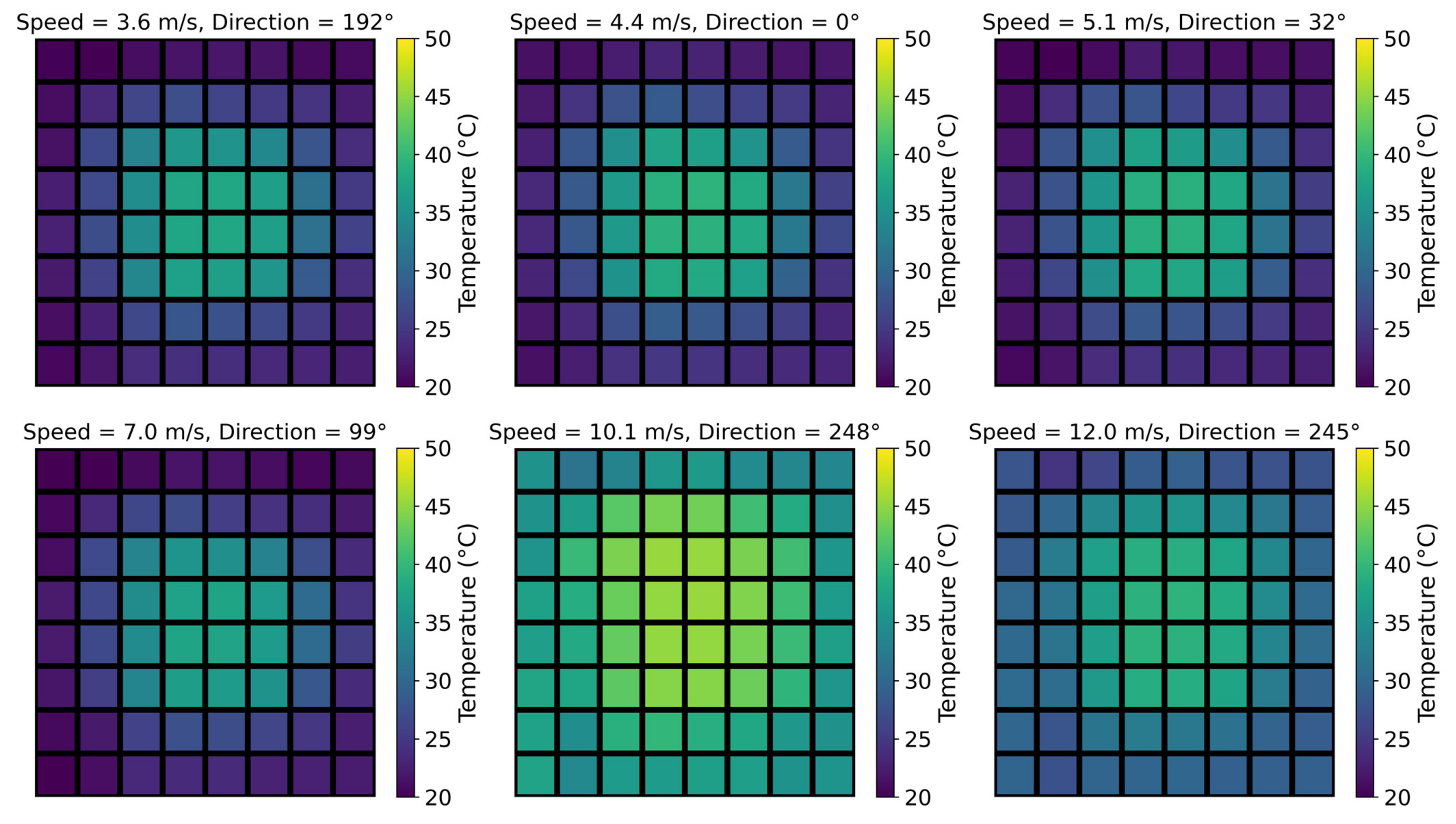
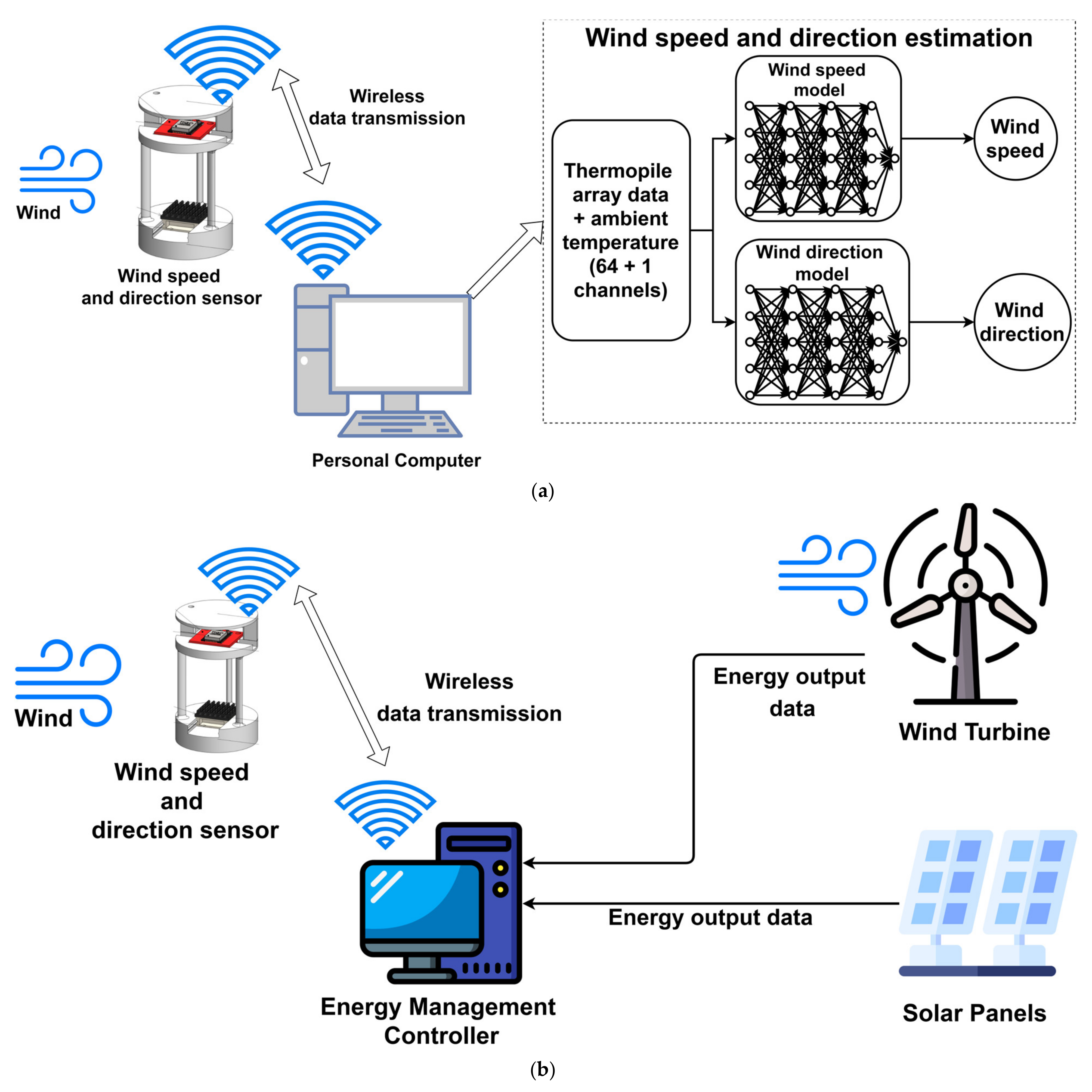

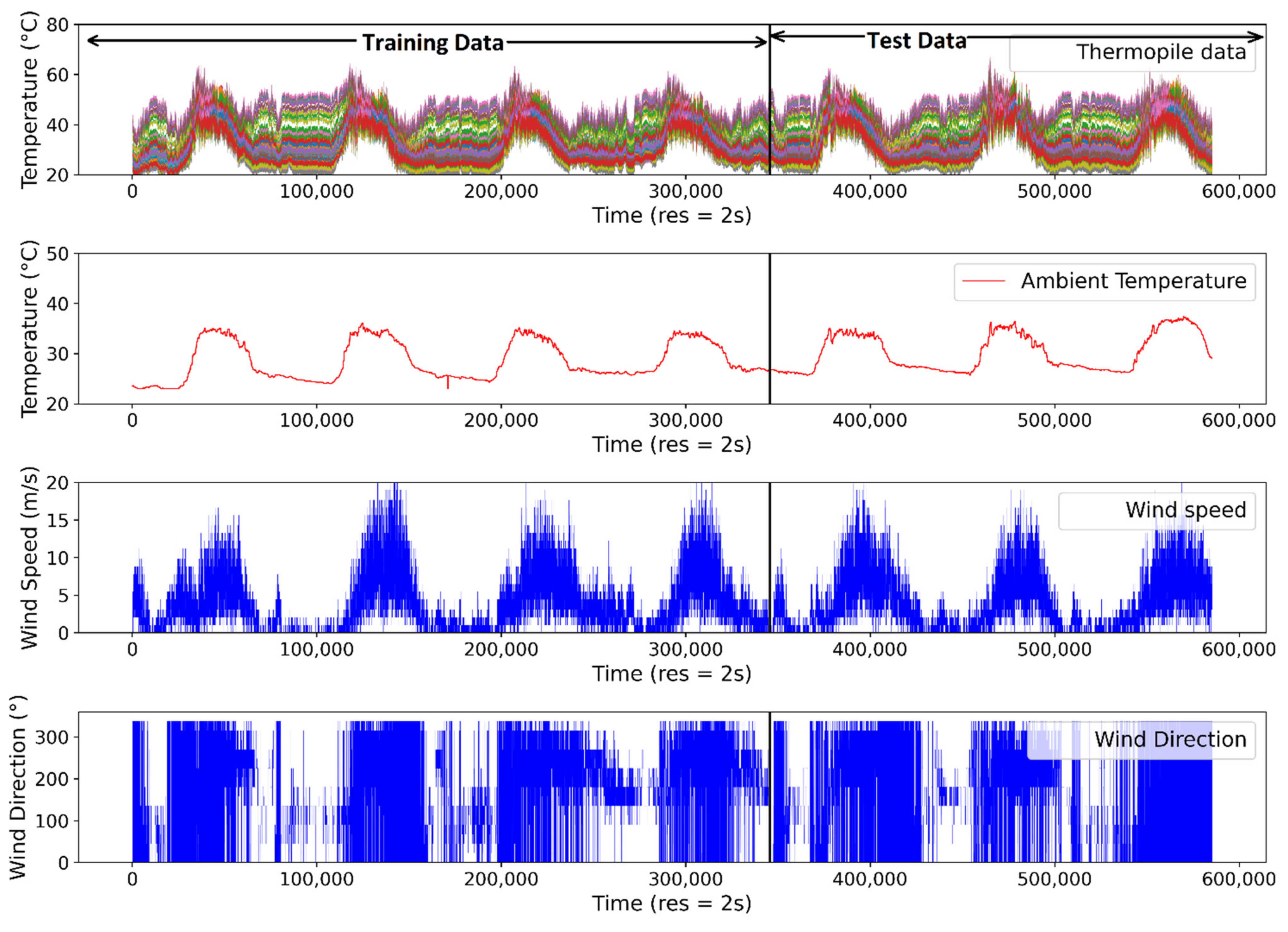

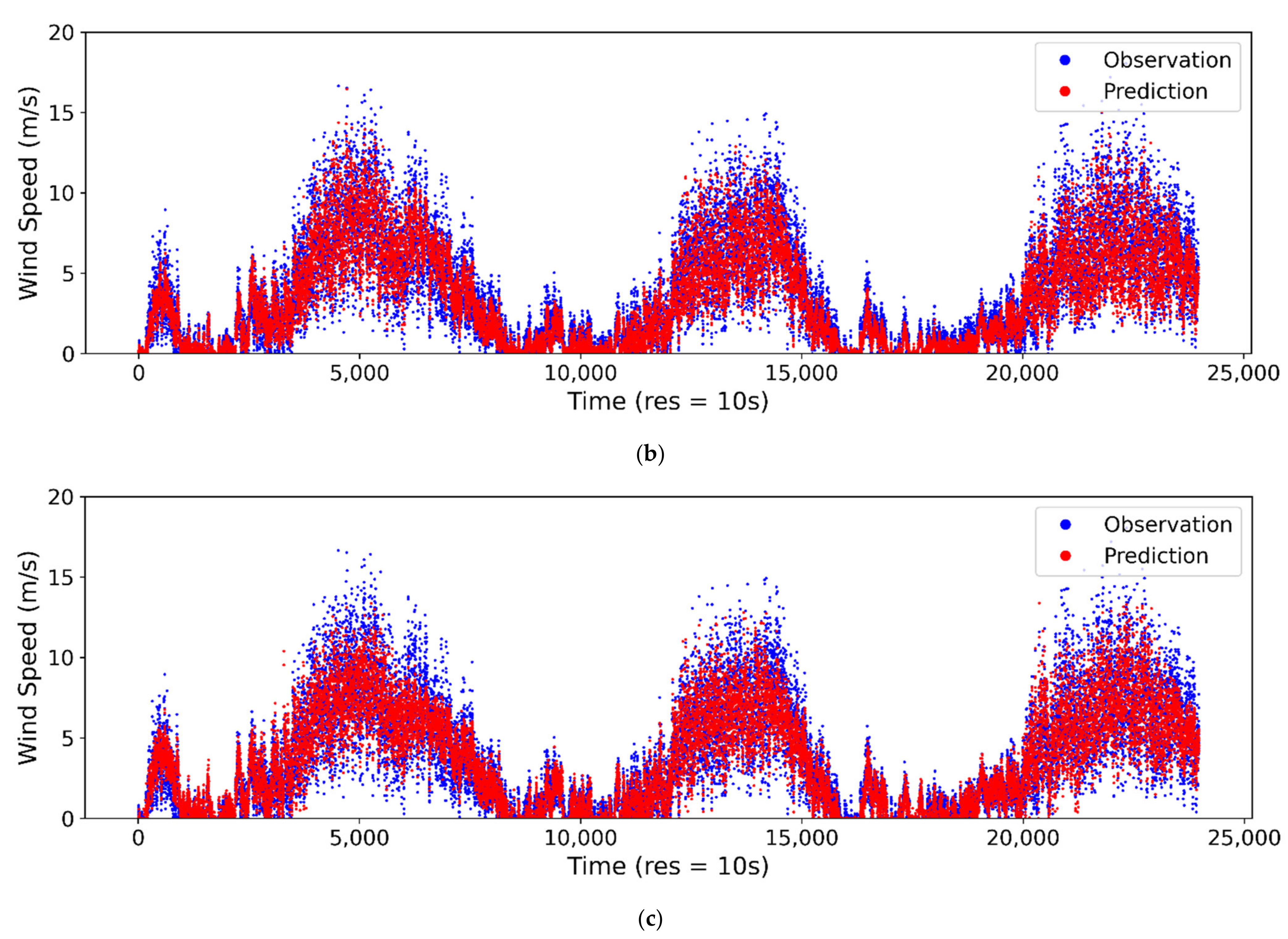

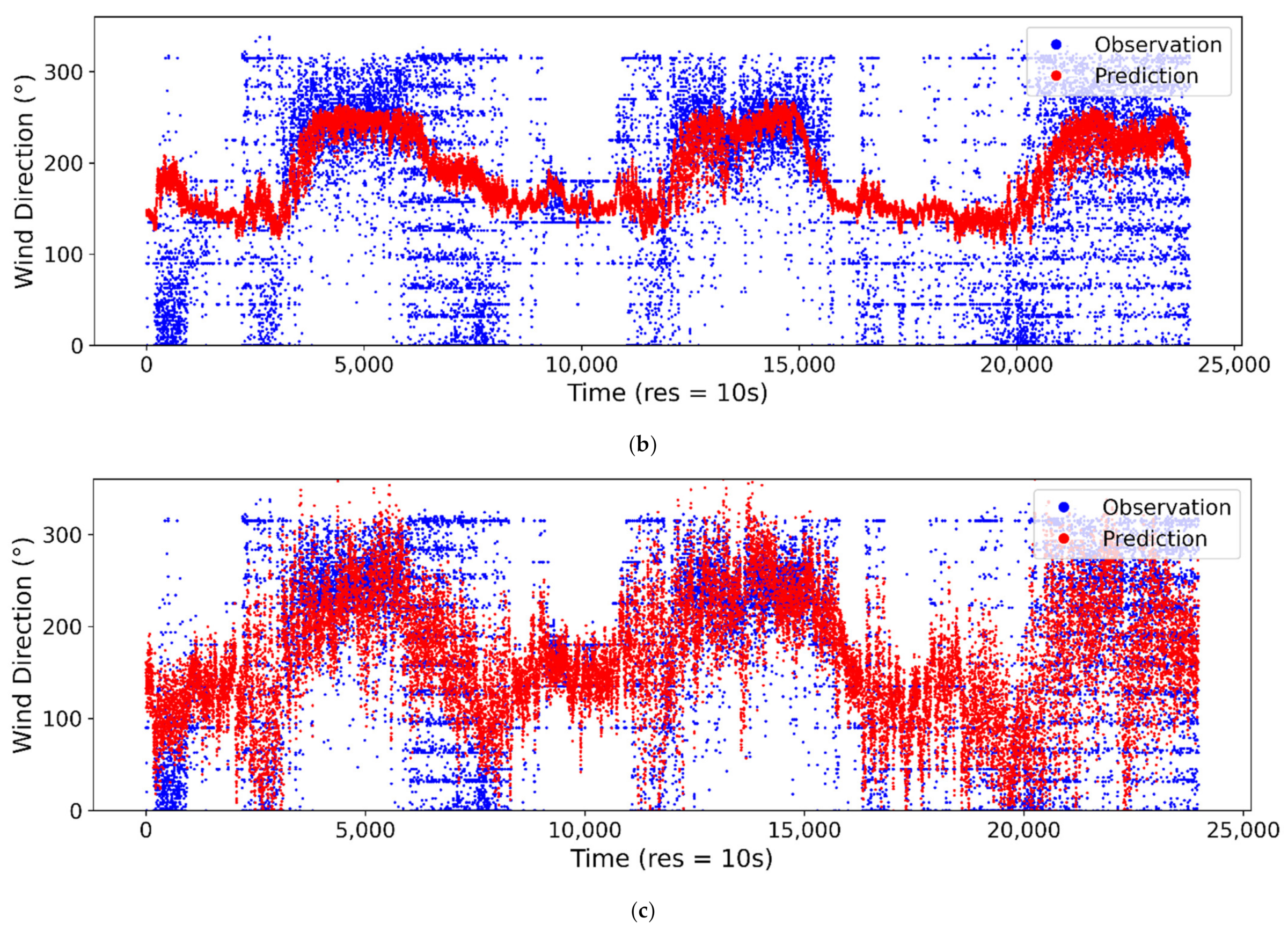
| Sampling Interval | Models | Wind Speed | Wind Direction | ||||
|---|---|---|---|---|---|---|---|
| R2 | RMSE | MAE | R2 | RMSE | MAE | ||
| 10 s | ANN | 0.916 | 0.949 | 0.622 | 0.835 | 36.89 | 23.923 |
| SVM | 0.904 | 1.017 | 0.676 | 0.34 | 69.01 | 56.097 | |
| LR | 0.892 | 1.078 | 0.759 | 0.58 | 61.997 | 46.43 | |
| 20 s | ANN | 0.936 | 0.809 | 0.525 | 0.834 | 32.967 | 23.322 |
| SVM | 0.908 | 0.974 | 0.653 | 0.35 | 69.819 | 51.471 | |
| LR | 0.912 | 0.953 | 0.679 | 0.637 | 54.226 | 40.487 | |
| 1 min | ANN | 0.954 | 0.653 | 0.437 | 0.874 | 28.331 | 16.809 |
| SVM | 0.929 | 0.811 | 0.559 | 0.388 | 62.697 | 44.167 | |
| LR | 0.935 | 0.775 | 0.574 | 0.725 | 42.283 | 31.415 | |
| 2 min | ANN | 0.969 | 0.516 | 0.353 | 0.889 | 22.211 | 17.223 |
| SVM | 0.947 | 0.684 | 0.484 | 0.359 | 59.674 | 42.4 | |
| LR | 0.95 | 0.663 | 0.503 | 0.782 | 34.471 | 26.08 | |
| 5 min | ANN | 0.981 | 0.4 | 0.278 | 0.917 | 17.685 | 12.961 |
| SVM | 0.964 | 0.546 | 0.392 | 0.354 | 58.037 | 43.038 | |
| LR | 0.963 | 0.556 | 0.425 | 0.832 | 27.732 | 21.179 | |
| 10 min | ANN | 0.99 | 0.279 | 0.207 | 0.941 | 16.836 | 13.657 |
| SVM | 0.969 | 0.505 | 0.373 | 0.355 | 53.398 | 40.549 | |
| LR | 0.966 | 0.528 | 0.389 | 0.862 | 23.614 | 17.985 | |
Publisher’s Note: MDPI stays neutral with regard to jurisdictional claims in published maps and institutional affiliations. |
© 2021 by the authors. Licensee MDPI, Basel, Switzerland. This article is an open access article distributed under the terms and conditions of the Creative Commons Attribution (CC BY) license (https://creativecommons.org/licenses/by/4.0/).
Share and Cite
Wu, S.-C.; Tzou, J.-C.; Ding, C.-Y. A Low-Cost System for Measuring Wind Speed and Direction Using Thermopile Array and Artificial Neural Network. Appl. Sci. 2021, 11, 4024. https://doi.org/10.3390/app11094024
Wu S-C, Tzou J-C, Ding C-Y. A Low-Cost System for Measuring Wind Speed and Direction Using Thermopile Array and Artificial Neural Network. Applied Sciences. 2021; 11(9):4024. https://doi.org/10.3390/app11094024
Chicago/Turabian StyleWu, Shang-Chen, Jong-Chyuan Tzou, and Cheng-Yu Ding. 2021. "A Low-Cost System for Measuring Wind Speed and Direction Using Thermopile Array and Artificial Neural Network" Applied Sciences 11, no. 9: 4024. https://doi.org/10.3390/app11094024





